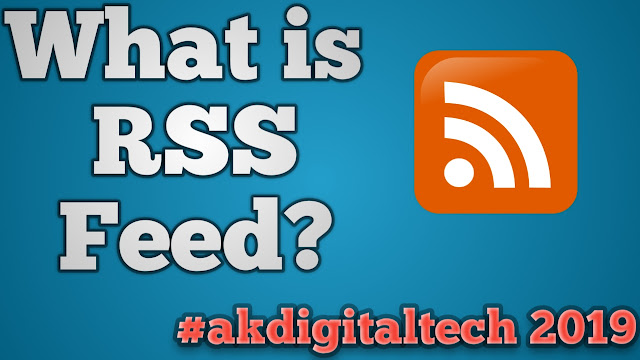Welcome to my Digital Tech. Akshay Blog. In this blog, you will find all the information about digital technology. In today's article, we will talk about RSS feeds. Comment on how you feel about the last few articles.
Post Content:-
1) What is RSS feed?
2) How does RSS feed works?
3) Advantages of RSS feed.
Post Content:-
1) What is RSS feed?
2) How does RSS feed works?
3) Advantages of RSS feed.
Friends, you have seen the symbol of RSS feeds on every website or blog. But what is this RSS feed? How can we use it? What are the benefits of RSS feeds? In today's article, we will talk about RSS feeds.
The people who spend more time on the internet will know about RSS feeds. In every website or blog, we get an RSS feed option. If you are a new blogger or have you just started blogging, then it is important for you to know that, what is the RSS feeds? So let us know about RSS feeds.
➥What is RSS feed?
RSS feeds are a type of web feed that allows us to receive daily content from the other website, automatically receives in our Gmail account. RSS feeds are also called Rich Site Summary and Really Simple Syndication. The website specifically uses RSS feed to update information. Such as blog entries, news headlines, or to publish audio and video series.
In an article of RSS feed, you get to see content, author name, date and complete article. After subscribing to an RSS feed of a website, you do not need to manually check the website for new content. In addition, the browser they have is always constantly monitored on that site and informs the sub-rating of any update. The browser can also be ordered to automatically download new data for subscribers.
If we subscribe to a website's feed, after subscribing, whenever a new content update is found on that website, then information is automatically found on our email ID. If you are a new blogger or you have just started blogging, then you must use RSS Feed in your blog so that the updates to your new article will continue to meet your feed subscribers or readers immediately.
➥How does RSS feed work?
RSS feeds are a type of web feed that we get updates of new articles daily. The web feed is a data format used to provide subscribers often-updated content. Content distributors syndicate a web feed so that users can subscribe to one channel. Creating a collection of web feeds in one place is known as aggregation, which is done by a news aggregator. A web feed is sometimes called a syndicated feed.
The RSS feed works on the news aggregator's name or software. The basically News Aggregator is also called feed aggregator, feed reader, newsreader, RSS reader or simply aggregator. This is an application that collects articles, blogs, vlogs, for easy viewing in one place. You will first need to install the Feedreader application, then you will be able to use RSS feeds.
The RSS feed reader uses Extensible Markup Language (XML), which displays the information in subscriber favorable interface. In today's world, the process of RSS feeds has become automatic. The RSS feed option already exists in any blog or website. All you have to do is click on that blog or to subscribe to the website.
➥Advantages of RSS Feeds: -
➠By using RSS Feed, you can save a lot of time. Once you subscribe to an RSS feed of a website, you do not have to open the website frequently to see its update.
➠RSS feed is the most used for Google Reader. There are more RSS feeds than Google Reader. But most people use Google Reader only.
If you are a WordPress user, then you will get a default RSS Feed feature on WordPress. But it is not user-friendly! You can run your feed with the help of FeedBurner and use it as an email subscription.
If you use Blogger.com, you already have Google's default RSS feed feature.
If you use Blogger.com, you already have Google's default RSS feed feature.
I would like you to enjoy this article and together I also hope that you will choose a great theme for the upcoming blog. If you have any questions about What is RSS Feeds? an article, then please comment to me or you can follow me on social media and ask me your questions.
Thanks for visiting this blog and article.








0 Comments